This week the news hit that the novel coronavirus that has plagued central China continued its expansion around the world, with the northern Italy Lombardy region the hardest hit. A friend in Venice posted a note saying her family opted to drive to the Italian Alps rather than take a chance flying in an incubation tube. I’m happy that my trip to Italy was several years ago and I have great memories.
Milan is the capital of the Lombardy region, which also encompasses Como and the lakes. My time in Milan was precious. Our arrival by train brought us into Duomo Station, not far from the intricate façade of Milan Cathedral, the largest church in Italy. As soon as we entered the square we were besieged by men giving out “free” colored thread wrist bands. Free in the sense that they tied them to your wrists for free before haranguing you for payment. Still, the square was lively and the cathedral magnificent. Between eating pasta near the Duomo and dinner on Via Dante, a pedestrian side street featuring international flags and a plethora of sidewalk cafes, we explored the Castello Sforzesco (Sforza Castle) and environs. As much as we enjoyed it, the next day in Milan provided the highlight.
After a morning roaming the new architecture of the Missori neighborhood, and the archeological ruins along Via Ticinese, we made our way to Piazza Santa Maria delle Grazie with its famous convent. Entering the attached refectory at our ticketed time, we joined a small group waiting for entrance into a anteroom separated from the main hall by glass doors. These elaborate precautions are taken to limit the number of people – and more importantly, volume of warm air – allowed in the refectory at any given time. Inside we are given a scant fifteen minutes to view, and be awed, by Leonardo da Vinci’s pseudo-fresco masterpiece, The Last Supper.
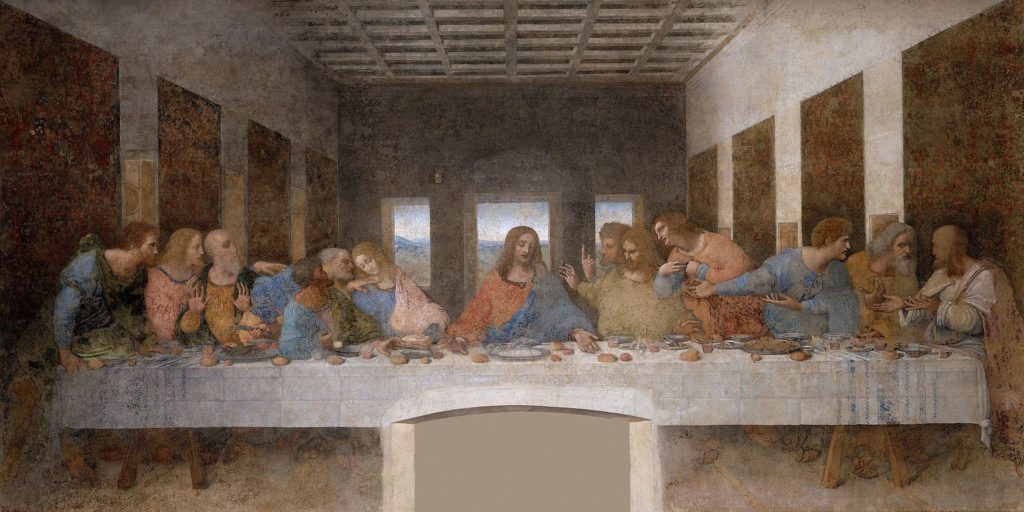
Perhaps the world’s most recognized painting (in competition with Da Vinci’s other masterpiece, the Mona Lisa), The Last Supper is even more amazing to see in person. Taking up one wall on the short end of a long ancient dining room, the painting depicts Jesus dining with his twelve apostles, moments after he says that one of them will betray him. This dramatic moment is perhaps exceeded only by the drama the mural has undergone during its over 500 year history. Surviving a bombing that destroyed much of the building during World War II, the delicate nature of fresco (or in this case, da Vinci’s modified version of fresco) has meant repeated damage and restoration. At one point a doorway was cut in the wall, chopping off the feet of Jesus and others originally seen under the table.
I’ve been to Rome several times, as well as Venice on a separate visit, but this trip offered me the greatest appreciation of the wonders of Italy. Taking trains between cities, I saw the Sistine Chapel in Vatican City; the Leaning Tower in Pisa; Michelangelo’s David, Brunelleschi’s Dome, and the Uffizi Gallery in Florence; the two towers of Bologna; and now The Last Supper in Milan.
As I read about the encroaching coronavirus in Italy, South Korea, and the world, I’m reminded that my travel schedule has been lessened in recent months. Perhaps it has been a good thing to stay home for a while, but hopes are that the current epidemic doesn’t turn into a pandemic and limit travel for much longer. My heart goes out to friends in China who have been sequestered by government order for many weeks, especially knowing how small most homes are there.
Italy will again be on my radar once I get back out into the travel world, as will the other two dozen “must-see” places I still haven’t seen. Until then, it’s write, write, write.
David J. Kent is an avid science traveler and the author of Lincoln: The Man Who Saved America, in Barnes and Noble stores now. His previous books include Tesla: The Wizard of Electricity and Edison: The Inventor of the Modern World and two specialty e-books: Nikola Tesla: Renewable Energy Ahead of Its Time and Abraham Lincoln and Nikola Tesla: Connected by Fate.
Check out my Goodreads author page. While you’re at it, “Like” my Facebook author page for more updates!



 Samuel Clemens, known to most of us by his pseudonym Mark Twain, was born in Hannibal, Missouri on November 30, 1835, shortly after Halley’s Comet had made its regular but rare pass by the Earth. The 26-year-old Abraham Lincoln – an amateur astronomy buff who two years earlier had marveled at the Leonid meteor showers – may very well have been gazing at the skies when Mark Twain came into this world. At that age Lincoln lived in New Salem, Illinois, just a stone’s throw across the Mississippi River from Hannibal. In 1859, Lincoln rode the Hannibal and St. Joseph Railroad to give a speech in Council Bluffs, Iowa. The railroad just happened to be formed in the office of Mark Twain’s father thirteen years before.
Samuel Clemens, known to most of us by his pseudonym Mark Twain, was born in Hannibal, Missouri on November 30, 1835, shortly after Halley’s Comet had made its regular but rare pass by the Earth. The 26-year-old Abraham Lincoln – an amateur astronomy buff who two years earlier had marveled at the Leonid meteor showers – may very well have been gazing at the skies when Mark Twain came into this world. At that age Lincoln lived in New Salem, Illinois, just a stone’s throw across the Mississippi River from Hannibal. In 1859, Lincoln rode the Hannibal and St. Joseph Railroad to give a speech in Council Bluffs, Iowa. The railroad just happened to be formed in the office of Mark Twain’s father thirteen years before.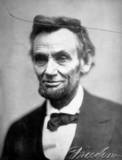 Lincoln floated flatboats down the Mississippi River to New Orleans as a young adult, then took steamboats back upriver. He often piloted steamboats around shoals near his New Salem home. Mark Twain had worked on steamboats on the river for much of his younger years, first as a deckhand and then as a pilot. Being a riverboat pilot gave him his pen name; “mark twain” is “the leadsman’s cry for a measured river depth of two fathoms (12 feet), which was safe water for a steamboat.” In 1883 Twain even titled his memoir, Life on the Mississippi. As we have already seen, Lincoln’s time traveling on and piloting steamboats eventually inspired his patent for lifting boats over shoals and obstructions on the river.
Lincoln floated flatboats down the Mississippi River to New Orleans as a young adult, then took steamboats back upriver. He often piloted steamboats around shoals near his New Salem home. Mark Twain had worked on steamboats on the river for much of his younger years, first as a deckhand and then as a pilot. Being a riverboat pilot gave him his pen name; “mark twain” is “the leadsman’s cry for a measured river depth of two fathoms (12 feet), which was safe water for a steamboat.” In 1883 Twain even titled his memoir, Life on the Mississippi. As we have already seen, Lincoln’s time traveling on and piloting steamboats eventually inspired his patent for lifting boats over shoals and obstructions on the river.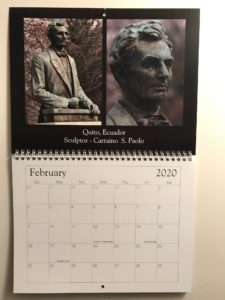 As Lincoln’s birthday week begins I turn to the David Wiegers calendar for another international statue of Abraham Lincoln. This one is in Quito, Ecuador.
As Lincoln’s birthday week begins I turn to the David Wiegers calendar for another international statue of Abraham Lincoln. This one is in Quito, Ecuador.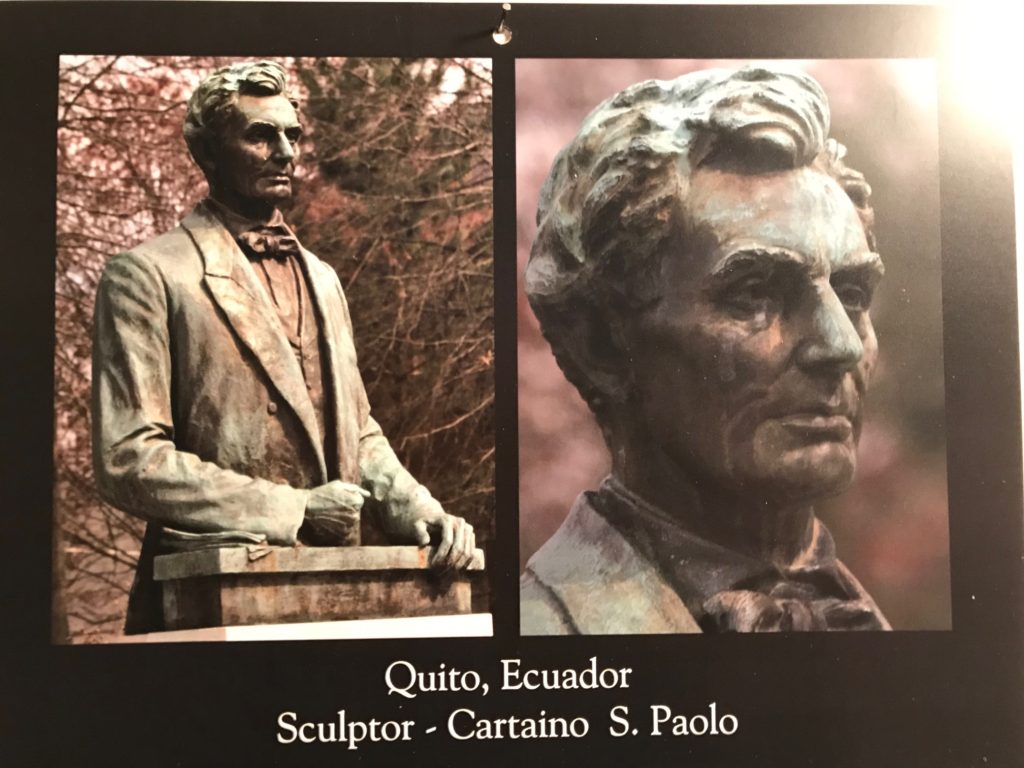
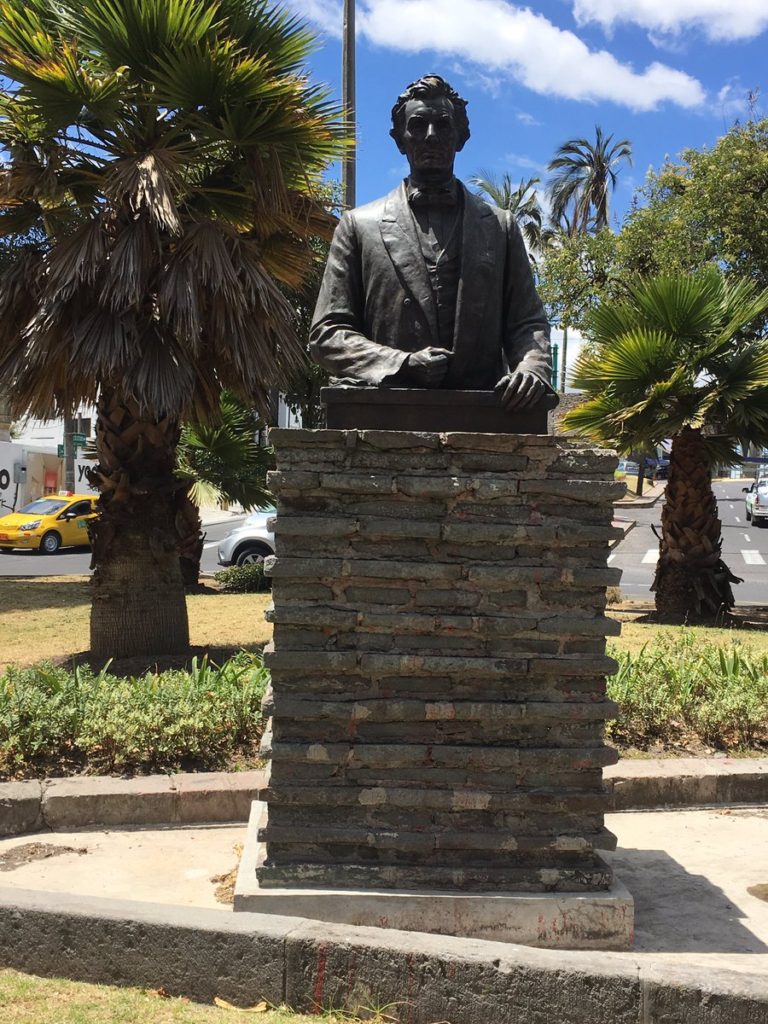
 Abraham Lincoln is best known for his Emancipation Proclamation, Gettysburg Address, and saving the Union during the Civil War. But in this Black History Month it’s important to remember that Lincoln also pushed for black voting rights.
Abraham Lincoln is best known for his Emancipation Proclamation, Gettysburg Address, and saving the Union during the Civil War. But in this Black History Month it’s important to remember that Lincoln also pushed for black voting rights.






